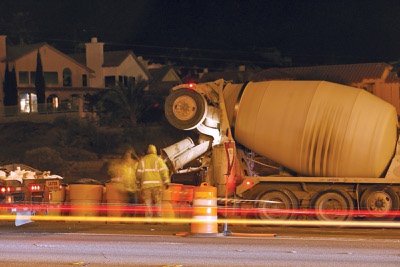
Workers set up jersey walls along Northbound U.S. 93 in January. Acceleration lanes near Lake Mountain Drive, Ville Drive and Pacifica Way will be widened, and six-inch-high raised curbs outlining the turn lanes will be installed in preparation for the increase in traffic expected when the Hoover Dam bypass bridge opens.
Monday, Jan. 12, 2009 | 10:03 a.m.
The Boulder City Bypass is not forgotten, state officials said last week.
It might need to be renamed, though, to gain the attention it deserves as a regional roadway, not just one for the town of 16,000, they said Wednesday.
As improvements began on U.S. 93 last week, officials of the state Department of Transportation said they are working on securing the rights of way for the first phase of the project, which will connect Interstate 515 from Railroad Pass to U.S. 95 south.
The bypass is designed to take the heavy truck traffic expected to start coming through Boulder City next year south of town.
Once the Hoover Dam bypass bridge opens next year, allowing heavy truck traffic to cross the Colorado River on U.S. 93 again, the department expects 2,000 trucks a day to pass through Boulder City between Arizona and Las Vegas. Since Sept. 11, 2001, tractor-trailers have been banned from crossing Hoover Dam, forcing them to detour through Laughlin.
Though the bridge is scheduled to be completed next year, the bypass around Boulder City has only a fraction of the $500 million it will need, and it is not expected to be built until 2025. NDOT has begun work on the U.S. 93 truck route to improve safety for residents who live in the Hemenway Valley.
Money is available to purchase the rights of way, NDOT Director Susan Martinovich said, and having those rights lined up will put the project in a better position to receive funding. She expected the process to take 18 months to three years if no property owners challenge the state in court.
Funding has been difficult, Martinovich said, because the project has to compete with other needed highways, interchanges and new projects that are used by a hundred times as many cars a day as U.S. 93 through Boulder City.
The state is $4 billion short of funding for its transportation needs, Kent Cooper, NDOT assistant director of engineering, said.
The safety improvements on U.S. 93 begun last week include road widening, medians and acceleration lanes to improve safety for cars once trucks are allowed back on the route, NDOT officials said.
But the ultimate safety measure would be to divert those trucks and interstate cars south of Boulder City, NDOT officials agreed.
More than eliminating congestion, pollution and accidents in Boulder City, the 13-mile route would help interstate commerce, making for a faster trip between Phoenix and Las Vegas for trucks delivering goods, Martinovich said.
The road is a major north-south route in the West and part of the Canamex Highway, Cooper said.
That makes it a regional and national issue, they said, and Mayor Roger Tobler agreed.
"We've got to stop playing this off as a Boulder City project," Tobler said, suggesting that he would like to see the name changed to reflect that broader scope.
The funding allocated to the project so far has consisted of federal earmarks pushed through by Nevada's congressional delegation, and Martinovich said NDOT is determined to ensure none of that money is wasted. Some of will expire in September if it is not spent, she said.
"We're going to spend all the money and move forward at least to keep that synergy going," she said.
The agency hopes to finalize its right-of-way plans for the first phase in April, Martinovich said.
That stretch runs through the property of eight different owners, including the Railroad Pass Casino and the Bureau of Land Management, Cooper said.
The initial phase is entirely designed, approved for environmental factors and 60 percent funded, but NDOT needs to acquire the lands before it can lay down asphalt, Martinovich said.
Martinovich and Tobler both said the bypass would be helped if the Legislature would make tolling legal in Nevada. They see the project as a good candidate for public-private partnership.
Assemblyman Joe Hardy, R-Boulder City this year again will ask the Legislature to allow tolling for the bypass, but Martinovich said it will be an uphill battle.
NDOT estimates show that toll income would not generate enough money over 20 years to build the bypass, but Martinovich said NDOT cannot even talk seriously to possible partners to see what is feasible as long as the law prohibits tolling.
On Jan. 2, traffic to cross Hoover Dam backed up well into Boulder City, past Buchanan Boulevard, delaying travel within town, as well as for tourists, Tobler said.
Even with the bridge replacing Hoover Dam's switchbacks, those kind of traffic jams could happen next year, he said.
Martinovich said despite constraints and hurdles during the budget crisis and amid other pressing priorities, the project is moving forward as quickly as possible.
"We totally appreciate and understand the concerns in Boulder City, and in 2010 the impact on the community," she said.
Cassie Tomlin can be reached at 948-2073 or [email protected].



Join the Discussion:
Check this out for a full explanation of our conversion to the LiveFyre commenting system and instructions on how to sign up for an account.
Full comments policy